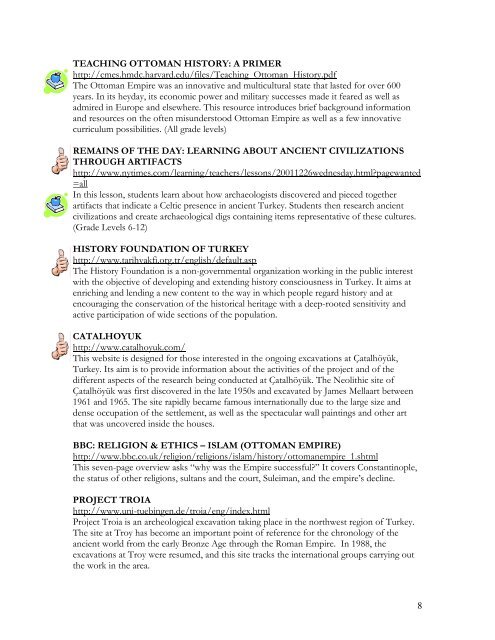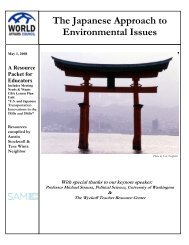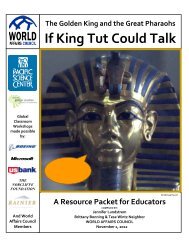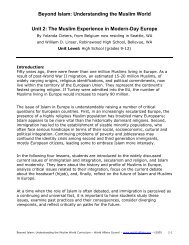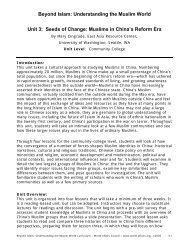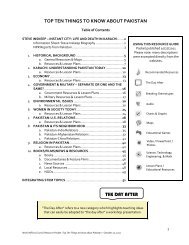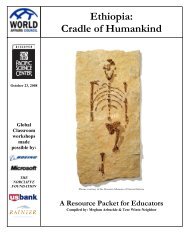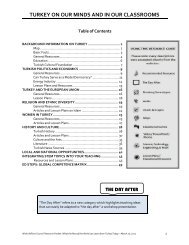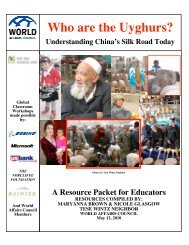Turkish Culture and Society - World Affairs Council
Turkish Culture and Society - World Affairs Council
Turkish Culture and Society - World Affairs Council
Create successful ePaper yourself
Turn your PDF publications into a flip-book with our unique Google optimized e-Paper software.
TEACHING OTTOMAN HISTORY: A PRIMER<br />
http://cmes.hmdc.harvard.edu/files/Teaching_Ottoman_History.pdf<br />
The Ottoman Empire was an innovative <strong>and</strong> multicultural state that lasted for over 600<br />
years. In its heyday, its economic power <strong>and</strong> military successes made it feared as well as<br />
admired in Europe <strong>and</strong> elsewhere. This resource introduces brief background information<br />
<strong>and</strong> resources on the often misunderstood Ottoman Empire as well as a few innovative<br />
curriculum possibilities. (All grade levels)<br />
REMAINS OF THE DAY: LEARNING ABOUT ANCIENT CIVILIZATIONS<br />
THROUGH ARTIFACTS<br />
http://www.nytimes.com/learning/teachers/lessons/20011226wednesday.html?pagewanted<br />
=all<br />
In this lesson, students learn about how archaeologists discovered <strong>and</strong> pieced together<br />
artifacts that indicate a Celtic presence in ancient Turkey. Students then research ancient<br />
civilizations <strong>and</strong> create archaeological digs containing items representative of these cultures.<br />
(Grade Levels 6-12)<br />
HISTORY FOUNDATION OF TURKEY<br />
http://www.tarihvakfi.org.tr/english/default.asp<br />
The History Foundation is a non-governmental organization working in the public interest<br />
with the objective of developing <strong>and</strong> extending history consciousness in Turkey. It aims at<br />
enriching <strong>and</strong> lending a new content to the way in which people regard history <strong>and</strong> at<br />
encouraging the conservation of the historical heritage with a deep-rooted sensitivity <strong>and</strong><br />
active participation of wide sections of the population.<br />
CATALHOYUK<br />
http://www.catalhoyuk.com/<br />
This website is designed for those interested in the ongoing excavations at Çatalhöyük,<br />
Turkey. Its aim is to provide information about the activities of the project <strong>and</strong> of the<br />
different aspects of the research being conducted at Çatalhöyük. The Neolithic site of<br />
Çatalhöyük was first discovered in the late 1950s <strong>and</strong> excavated by James Mellaart between<br />
1961 <strong>and</strong> 1965. The site rapidly became famous internationally due to the large size <strong>and</strong><br />
dense occupation of the settlement, as well as the spectacular wall paintings <strong>and</strong> other art<br />
that was uncovered inside the houses.<br />
BBC: RELIGION & ETHICS – ISLAM (OTTOMAN EMPIRE)<br />
http://www.bbc.co.uk/religion/religions/islam/history/ottomanempire_1.shtml<br />
This seven-page overview asks “why was the Empire successful?” It covers Constantinople,<br />
the status of other religions, sultans <strong>and</strong> the court, Suleiman, <strong>and</strong> the empire’s decline.<br />
PROJECT TROIA<br />
http://www.uni-tuebingen.de/troia/eng/index.html<br />
Project Troia is an archeological excavation taking place in the northwest region of Turkey.<br />
The site at Troy has become an important point of reference for the chronology of the<br />
ancient world from the early Bronze Age through the Roman Empire. In 1988, the<br />
excavations at Troy were resumed, <strong>and</strong> this site tracks the international groups carrying out<br />
the work in the area.<br />
8


